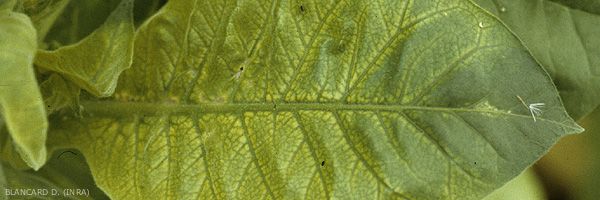
Various chemical injuries
Herbicides, in particular by disrupting the photosynthetic activity of plants, are responsible for more or less generalised yellowing of some leaves which afterwards tend to turn white rather quickly. We recommend you have a look at the photos of tobacco leaves that illustrate the nature and distribution of yellowing caused by herbicides. Be aware that using herbicides on crops or close to them is never totally harmless. It may only be done by using particular doses and during particular stages of plant growth; the risks of chemical injuries never totally vanish.
Other pesticides, for example mixtures of insecticides and fungicides, or fertilisers may likewise cause chemical injuries on tobacco. They also cause yellowing and abnormal leaf shape.
In addition to the symptoms shown in the photos, we propose an indicative description of the lesions reported in the literature or observed in tobacco plants deliberately treated with principal herbicides used in agriculture. A single herbicide may induce multiple symptoms on a plant.
What are the different symptoms of chemical injuries ?
- change in leaf colour with different types of yellowing:
- diffused yellowing of the entire lamina (figure 1);
- yellow, more or less well isolated spots or specks figure (pyridate. ..) (figure 2);
- vein yellowing and /or adjacent tissues (linuron, diuron ...) (figure 3);
- yellowing of young apex leaves (atrazine. ..);
- very strong yellowing of young apex leaves followed by bleaching including the lamina portion near the petiole (glyphosate. ..) (figure 4);
- diffused yellowing of the lamina between the veins (metobromuron, carbetamide ...);
- more or less uniform yellowing of the lamina tissue between the veins sometimes followed by bleaching (simazine, terbuthylazine, metobromuron, metribuzin ...) (figure 5);
- rapidly evolving drying and yellowing between the veins (simazine, terbuthylazine, metobromuron ...);
- bleaching of the lamina (figures 6 and 7)).
- But also :
- change of plant habit and leaf shape (figure 2a) (see Abnormal leaf shape or size)
- and finally wilting and leaf necrosis (see Wilted and dry leaves)
The origin of a chemical injury is difficult to determine. As a matter of fact, producers often reject the possibility of having committed an error or caused damage. Let us recall that in most cases the study of symptom distribution in time and space confirms the hypothesis of a chemical injury.
- Symptom distribution in time
This refers to the time required between the addition of a product causing chemical injury and the onset of symptoms, and it may vary between:
- very short (the relationship of cause and effect is fast), immediately after application of a pesticide on or near the crop (such as spraying);
- quite long, in case of, for example, an inappropriate previous crop (previous annual or perennial crop with residual herbicide or poorly leached after a dry winter, perennial crop treated with herbicides for several years This situation leads to product accumulation in the soil, or after addition of straw from a cereal crop or weed manure made from similar straw.
- Symptom distribution in space
This means the localisation of symptoms on plants and in the plot. It can vary depending on the composition of the phytotoxic compound, its mode of application and its location:
- If the phytotoxic compound is applied on the leaves (foliar herbicide, overdosed insecticide...), the distribution of diseased plants can be general and homogeneous (figure 8), at the beginning of a row or only on one side of the plants;
- If the compound is present in the soil as a residue (e.g. root herbicide), the distribution of affected plants may be general and more or less homogeneous or randomly distributed over the whole plot.
Note that there are differences in varietal susceptibility as regards to the action of pesticides. It is therefore not surprising to observe this phenomenon if you grow several cultivars. Furthermore, we advise you to observe all the weeds still present in the crop, or other crops in the vicinity, which may suffer from the same chemical injury and therefore present the same symptoms. If this is the case, it partly confirms the hypothesis of the chemical injury. In fact, except for some viruses and Stolbur, the vast majority of parasitic diseases of tobacco cannot be observed on weeds and are mostly specific to tobacco or Solanaceae.
What to do after the chemical injury?
Although there is no quick remedy to this situation, the following measures should be taken:
- determine the origin of phytotoxicity precisely;
- prevent it happening again;
- do not remove the plants immediately, grow them normally and observe their evolution. The latter depends mainly on the dose and persistence of the used product;
- no other specific measures can be recommended.
In many situations the following questions might be asked:
- Have you treated with a with herbicide in the previous crop? Have you treated with a herbicide near your tobacco field?
- Have you rinsed your treatment equipment thoroughly? Have you used the appropriate product with appropriate doses? - Have you mixed products that cannot be mixed?
Beware that irrigation water may be polluted by herbicides.





